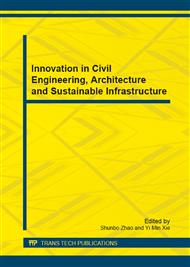[1]
Alterman Z. S., Karal F. C, Propagation of elastic waves in layered media by finite-difference methods, J. Bull. Seism. Soc. Am., 58 (1968) 367-398.
Google Scholar
[2]
Givoli D, Numerical Methods for Problems in Infinite Domains, third ed., Elsevier, Amsterdam, 1992.
Google Scholar
[3]
Banerjee P K, The Boundary Element Methods in Engineering, second ed., McGraw-Hill, London, 1994.
Google Scholar
[4]
Bettess P, Zienkiewica O C, Diffraction and refraction of surface waves using finite and infinite elements, J. Int. J. for Num. Meth. Ineng., 11 (1977) 1271-1290.
DOI: 10.1002/nme.1620110808
Google Scholar
[5]
C. Zhao, C. Zhang, G. Zhang, Simulation of semi-infinite plane elastic foundation using infinite elements, J. Tsinghua University (Science and Technology), 26 (1986) 51-64.
Google Scholar
[6]
Lysmer J, Lumped mass method for Rayleigh waves, J. Bulletin of the seismological Society of America, 60 (1970) 89-104.
DOI: 10.1785/bssa0600010089
Google Scholar
[7]
Kausel E, J M Rossess, G Wags, Dynamic analysis of footings on layered media, J. Engineering Mechanics, ASCE, 101 (1975) 679-693.
DOI: 10.1061/jmcea3.0002059
Google Scholar
[8]
Manolis G D, D E Beskos, Boundary Element Methods in Elastodynamics, first ed., Unwin Hyman, London, 1988.
Google Scholar
[9]
Lysmer J, Kulemeyer R L, Finite dynamic model for infinite media, J. Engng. Mech. Div., ASCE, 95 (1969) 859-877.
DOI: 10.1061/jmcea3.0001144
Google Scholar
[10]
Dominguez J, Maeso O, Model for the seismic analysis of arch dams including interaction effects, 10th World Conference of Earthquake Engineering, Madrid, 8 (1992) 4601-4606.
Google Scholar
[11]
Clayton R, Engquist B, Absorbing boundary conditions for wave-equation migration, J. Geophysics, 45 (1980) 859-904.
DOI: 10.1190/1.1441094
Google Scholar
[12]
Clayton R, Engquist B, Absorbing boundary conditions for acoustic and elastic wave equations, J. Bull. Seism. Soc. Amer., 76 (1977) 1529-1540.
DOI: 10.1785/bssa0670061529
Google Scholar
[13]
Smith W, A non-reflecting plane boundary for wave propagation problems, J. Comp. Phys., 15 (1973) 492-503.
Google Scholar
[14]
Kunar R. R, Marti J, A non-reflecting boundary for explicit calculations, J. Computational methods for infinite domain media-structure interaction, ASME, 46 (1981) 183-204.
Google Scholar
[15]
Z. Liao, K. Huang, B. Yang. Transmitting boundaries to transient wave, J. Scientia Sinica Mathemation, 26 (1984) 50-56.
Google Scholar
[16]
Deeks A. J., Randolph M. F., Axisymmetric time-domain transmitting boundaries, J. Engineering Mechanics, 120 (1994) 25-42.
DOI: 10.1061/(asce)0733-9399(1994)120:1(25)
Google Scholar
[17]
G. Gu, Earthquake Engineering for Earthrock Dams, second ed., China WaterPower Press, Beijing, 2009.
Google Scholar
[18]
J. Liu Jingbo, Y. Lv, A direct method for analysis of dynamic soil-structure interaction, China Civil Engineering Journal, 31 (1998) 55-64.
Google Scholar


